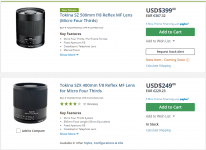
Tokina announced a 400 mm mirror lens which comes with a 2x TC for equivalent reach like a 1600 mm lens! The weight of the lens itself seems to be 355 g, what it would be with the whole kit ()including mount adapter) I do not know.
 tokinalens.com
Niels
tokinalens.com
Niels






